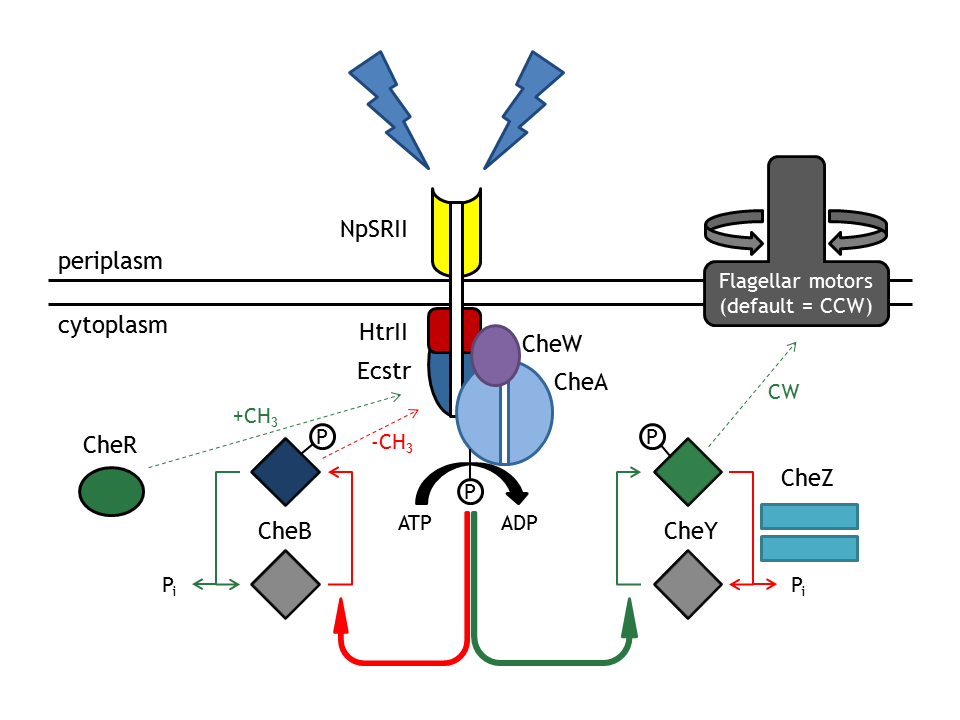Team:ETHZ Basel/Biology/Archeal Light Receptor
From 2010.igem.org
Archeal Light Receptor
Besides the light-sensitive Pif3/PhyB-system, another implementation strategy caught our attention: The generation of our E. lemming by the fusion of an archean photoreceptor to a bacterial chemotactic transducer. This was successfully demonstrated by Jung et al. in 2001 [1], who fused the Natronobacterium pharaonis NpSRII (Np seven-transmembrane retinylidene photoreceptor sensory rhodopsins II) and their cognate transducer HtrII to the cytoplasmic domain of the chemotaxis transducer EcTsr of Escherichia coli.
Rhodopsins are photoreactive, membrane-embedded proteins, which are found not only in archaea, but in eubacteria and microbes as well. In Natronobacterium pharaonis, the NpSRII contains a domain of seven membrane-spanning helices, which carry out two distinct functions: Firstly, they serve as photo-inducible ion-pumps and secondly, as actors in the chemotaxis signaling network. This was proposed by Spudich et al. in 2001.
Encouraged by this work, we purchased the codon optimized version of the receptr fusion from geneart and cloned the archeal photoreceptor NpSRII as biobrick into the standardized vector pSB1C3 [http://partsregistry.org/Part:BBa_K422001 BBa_K422001]. For the expression (and experimental purposes), we used pACT3 (BamHI/HindIII) as plasmid backbone, which has a CmR gene (Chloramphenicol resistance) and is IPTG-inducibile (Isopropyl-ß-D-thiogalactopyranosid).
Primers for pACT3
Name: AR-BamHI-forward Scale: 0.04 umol Purification: Desalted 5' Mod.: None Inner Mod.: None 3' Mod.: None Type: DNA Sequence (5'-3'): GTG GAT CCA AGG AGA TAT ACA TAT GGT TGG TCT GAC CAC CCT G Length: 43 Aliquots: NONE
Name: AR-Hind-reverse
Scale: Genomics
Purification: Desalted
5' Mod.: None
Inner Mod.: None
3' Mod.: None
Type: DNA
Sequence (5'-3'): GCA AGC TTT TAA CCG CTA TAA ATT G
Length: 25
Aliquots: NONE
NpSRII
Sensory Rhodopsin II photocycle
References
[1] [http://jb.asm.org/cgi/content/full/183/21/6365?maxtoshow=&hits=10&RESULTFORMAT=1&andorexacttitle=and&andorexacttitleabs=and&fulltext=An+archaeal+photosignal-transducing+module+mediates+phototaxis+in+%27%27Escherichia+&andorexactfulltext=and&searchid=1&FIRSTINDEX=0&sortspec=relevance&resourcetype=HWCIT: Jung, Spudich, Trivedi and Spudich: An archaeal photosignal-transducing module mediates phototaxis in Escherichia coli. Journal of bacteriology. 2001; 21].
[2] [http://www.sciencemag.org/cgi/content/full/sci;293/5534/1499?maxtoshow=&hits=10&RESULTFORMAT=&andorexacttitle=or&andorexacttitleabs=or&fulltext=Crystal+Structure+of+Sensory+Rhodopsin+II+at+2.4+Angstroms&andorexactfulltext=or&searchid=1&FIRSTINDEX=0&sortspec=relevance&fdate=7/1/1880&tdate=10/31/2010&resourcetype=HWCIT,HWELTR: Hartmut Luecke, Brigitte Schobert, Janos K. Lanyi, Elena N. Spudich and John L. Spudich. Crystal Structure of Sensory Rhodopsin II at 2.4 Angstroms: Insights into Color Tuning and Transducer Interaction. Science Express. 2001; 293]
[3] [http://onlinelibrary.wiley.com/doi/10.1562/2006-07-05-RA-960/full: Enrica Bordignon, Johann P. Klare, Julia Holterhues, Swetlana Martell, Aliaksei Krasnaberski, Martin Engelhard and Heinz-Jürgen Steinhoff. Analysis of Light-Induced Conformational Changes of Natronomonas pharaonis Sensory Rhodopsin II by Time Resolved Electron Paramagnetic Resonance Spectroscopy. Photochemistry and Photobiology. 2007; 83 (2)]
[4] [http://www.ncbi.nlm.nih.gov/pmc/articles/PMC1302696/: Michael Hein, Ansgar A. Wegener, Martin Engelhard, and Friedrich Siebert. Time-Resolved FTIR Studies of Sensory Rhodopsin II (NpSRII) from Natronobacterium pharaonis: Implications for Proton Transport and Receptor Activation. Biophys J. 2003; 84]
[5] [http://www.cell.com/biophysj/abstract/S0006-3495(98)77588-5: Igor Chizhov, Georg Schmies, Ralf Seidel, Jens R. Sydor, Beate Lüttenberg and Martin Engelhard. The Photophobic Receptor from Natronobacterium pharaonis: Temperature and pH Dependencies of the Photocycle of Sensory Rhodopsin II. Biophysical Journal. 1898; 75(2)]
[6] [http://onlinelibrary.wiley.com/doi/10.1111/j.1751-1097.2009.00687.x/full: Gang Dai, Yoshikazu Ohno, Yoichi Ikeda, Jun Tamogami, Takashi Kikukawa, Naoki Kamo and Tatsuo Iwasa. Photoreaction Cycle of Phoborhodopsin (Sensory Rhodopsin II) from Halobacterium salinarum Expressed in Escherichia coli. Photochemistry and Photobiology.2010; 86(3)]
[7] [http://onlinelibrary.wiley.com/doi/10.1111/j.1751-1097.2008.00470.x/full: Young-Jun Kim, Igor Chizhov and Martin Engelhard. Functional Expression of the Signaling Complex Sensory Rhodopsin II/Transducer II from Halobacterium salinarum in Escherichia coli. Photochemistry and Photobiology. 2009; 85 (2)]
[8] [http://onlinelibrary.wiley.com/doi/10.1562/2006-03-20-IR-853/full: Kwang-Hwan Jung. The Distinct Signaling Mechanisms of Microbial Sensory Rhodopsins in Archaea, Eubacteria and Eukarya. Photochemistry and Photobiology. 2007; 83 (1)]
[9] [http://onlinelibrary.wiley.com/doi/10.1111/j.1432-1033.1992.tb16935.x/full: Birgit Scharf, Bernd Pevec, Benno Hess and Martin Engelhard. Biochemical and photochemical properties of the photophobic receptors from Halobacterium halobium and Natronobacterium pharaonis. European Journal of Biochemistry. 1992; 206 (2)]
[10] [http://onlinelibrary.wiley.com/doi/10.1046/j.1365-2958.2003.03395.x/full: Kwang-Hwan Jung, Vishwa D. Trivedi and John L. Spudich. Demonstration of a sensory rhodopsin in eubacteria. Molecular Microbiology. 2003; 47 (6)]
[11] [http://onlinelibrary.wiley.com/doi/10.1002/9783527629237.ch10/summary: Prof. Dr. Reinhard Krämer, Prof. Dr. Kirsten Jung, Sonja Brandt, and Nicole Frankenberg-Dinkel. Chapter 10: Photoreception and Signal Transduction. Bacterial Signaling. 2010.]
 "
"





